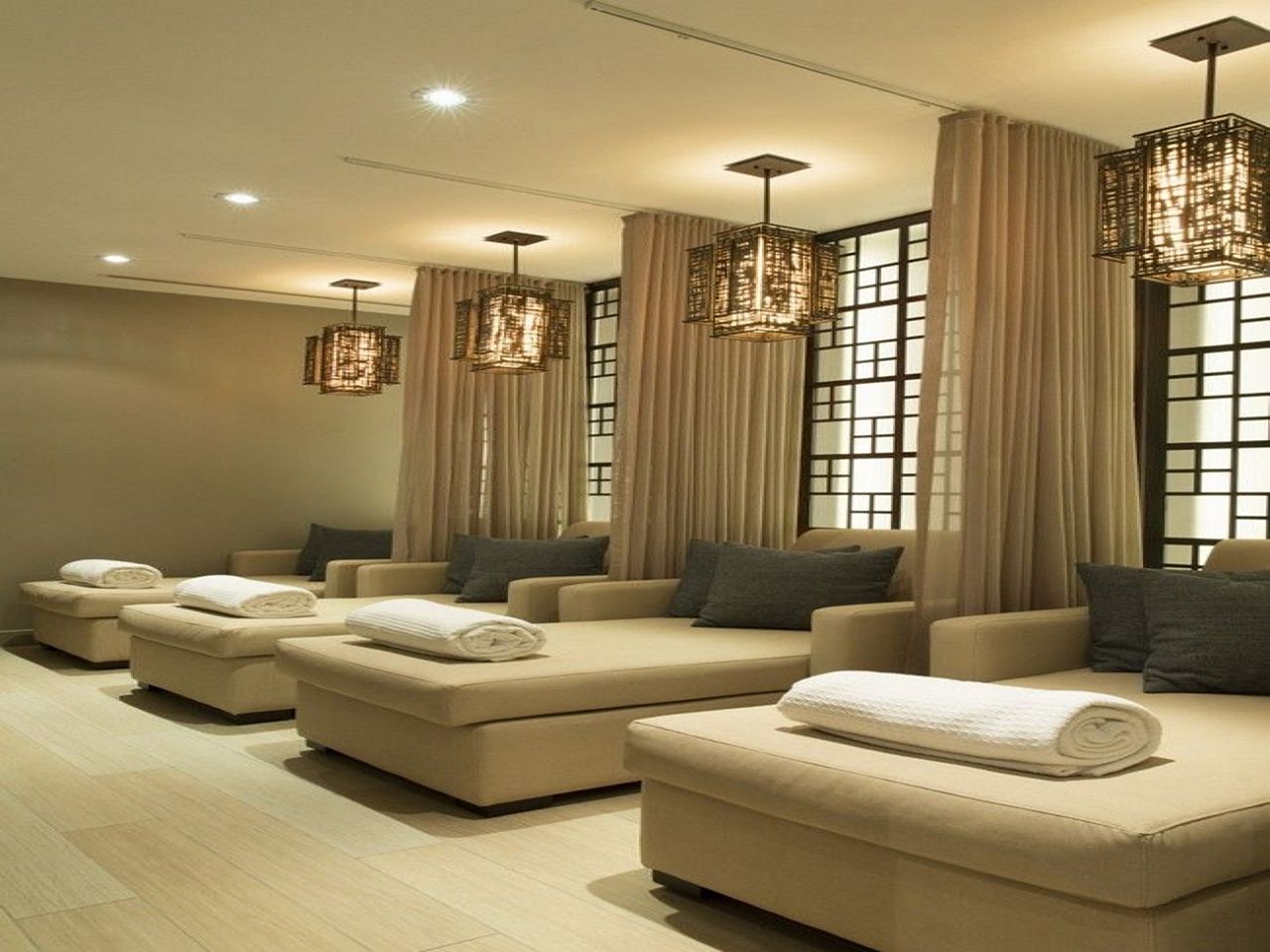Picture this: a place where medical expertise and spa-like bliss seamlessly intertwine. Welcome to the world of medical spa design! In this comprehensive guide, we’ll explore the art of creating spaces that cater to the needs of both patients and professionals, prioritizing well-being and style.
Medical Spa Interior Design: Your Guide to Creating a Tranquil Oasis
Walking into a medical spa shouldn’t feel like visiting a doctor’s office. It should feel like stepping into a serene escape where relaxation and rejuvenation reign supreme. Let’s delve into the secrets of designing a medical spa that achieves this delicate balance.
1. Welcoming Vibes from the Get-Go
- First Impressions Matter: The reception area should exude a cozy, living room atmosphere rather than a sterile waiting room. Plush seating, warm lighting, and calming water features can instantly put patients at ease.
- Privacy, Please!: Discretion is key when discussing treatment options. Strategically placed partitions or separate seating areas offer a more intimate feel.
2. Setting the Mood: It’s All in the Details
- Materials that Speak Volumes: Natural wood adds warmth, while soft fabrics invite touch. Choosing the right materials is crucial for ambiance. Consider calming colors, natural textures, and elements that reflect your spa’s unique personality.
- Art with a Purpose: Artwork should evoke emotions. Opt for pieces that complement your spa’s aesthetic and promote serenity. Abstract landscapes, botanical prints, or calming water scenes are all excellent choices.
3. Where Style Meets Functionality
- Timeless Elegance: Trends fade, but true style endures. Choose design elements that will stand the test of time, such as classic furniture lines, neutral color palettes, and high-quality materials.
- Seamless Flow and Soundproofing: Optimize your layout to ensure smooth transitions between rooms. Soundproofing is essential to prevent disruptions and maintain a tranquil atmosphere.
4. Comfort is King (or Queen!)
- A Treat for the Senses: Treatment rooms should prioritize both aesthetics and comfort. Choose furniture that’s as stylish as it is comfortable, ensuring patients feel pampered.
- Finding Your Way with Ease: Clear signage and intuitive room layouts contribute to a seamless and stress-free experience.
5. Tapping into Emotions
- A Healing Sanctuary: Your spa should be a haven for healing and rejuvenation. Incorporate calming colors, soft textures, and natural elements to create a sense of peace.
- Engaging the Senses: Appeal to all the senses with soothing sounds, calming scents like lavender or chamomile, and soft, diffused lighting.
6. Embracing the Future of Tech
- Touchless Convenience: Implement touchless check-in systems to prioritize hygiene, efficiency, and a modern feel.
- Virtual Reality: A Sneak Peek into the Future: Augmented reality consultations allow patients to experience treatments virtually, managing expectations and increasing satisfaction.
7. Sustainability: Because We Care
- Eco-Friendly Choices: Opt for eco-friendly materials, energy-efficient appliances, and sustainable practices to resonate with today’s conscious consumer.
- Energy Efficiency: Invest in energy-efficient lighting, heating, and cooling systems to reduce your spa’s carbon footprint and save on utility bills.
Creating an exceptional medical spa experience extends beyond treatments; it’s about crafting a space that nurtures both the body and the mind. By paying attention to detail and considering the emotional impact of your design choices, you can create a spa that keeps patients coming back for more.
Creating a Healing Ambiance: How to Design a Medically Sound and Serene Space
Creating a truly tranquil medical spa requires a deep understanding of how design elements impact patient well-being. Let’s explore how to create a space that promotes relaxation and healing from the moment patients arrive.
Think Like Your Patient: Comfort and Well-being from the Moment They Arrive
- The Waiting Area: This is your opening act. Instead of stiff chairs, envision plush seating, calming colors, and soft nature sounds. Provide engaging magazines or a beautiful water feature to help visitors unwind.
- Treatment Rooms: This is where the magic happens. Comfort and privacy are paramount. Consider soft, muted colors, luxurious fabrics, and adjustable chairs. Every detail, from temperature to lighting, should whisper “relaxation.”
Bringing the Outdoors In: Nature’s Calming Embrace
- Incorporating Natural Elements: Integrate elements like warm wood accents, a soothing water feature, or large windows that flood the space with natural light.
- The Power of Plants: Strategically placed plants add a breath of fresh air and enhance the feeling of tranquility.
Timeless Elegance: Creating a Space That Endures
- Classic Design Choices: Focus on creating a space that feels classic and enduring. Invest in high-quality furniture with clean lines and choose a neutral color palette that’s easy on the eyes.
- Personality and Sophistication: Add pops of personality with artwork or carefully selected accessories. Create an environment that feels both sophisticated and welcoming for years to come.
A Symphony of the Senses: Engaging Sight, Sound, and Smell
- Sound: Soft, ambient music works wonders in creating a peaceful atmosphere. Consider gentle instrumental music or nature sounds.
- Scent: Diffuse calming essential oils like lavender or chamomile. Choose subtle and universally appealing scents, as strong fragrances can be overwhelming.
- Touch: Every point of contact should feel luxurious, from plush towels to smooth, comfortable surfaces.
The Finishing Touches: Personalization and Sustainability
- Personalized Touches: Add thoughtful touches that personalize the space. Display locally crafted artwork or provide custom aromatherapy blends tailored to individual needs.
- Sustainability: Choose eco-friendly materials, invest in energy-efficient lighting, and consider implementing a recycling program.
By following these tips, you can create a spa environment that is not only aesthetically pleasing but also promotes healing and well-being. Remember, it’s about creating a sensory experience that soothes the mind, body, and spirit.
Citation:
Medical Spa Interior Design: Creating a Healing and Inviting Environment
Understanding Your Clientele: Who are You Designing Your Medical Spa For?
Designing a successful medical spa goes beyond choosing fluffy robes and calming colors. It requires a deep understanding of your target clientele. Let’s explore how to identify and cater to your ideal client.
Defining Your Ideal Client
- Demographics: Start with the basics: gender, age range, income levels, and occupations. These factors provide valuable insights into spending habits and preferences.
- Lifestyle and Motivations: Step into their shoes. What are their priorities and pain points? Are they busy moms craving “me time” or career-driven individuals seeking age-defying treatments?
- Industry Trends: Stay informed about the latest treatments, technologies, and buzzworthy trends to demonstrate that you’re in the know.
- Direct Feedback: Conduct surveys or organize focus groups to gather direct feedback from your target audience.
- Client Segmentation: Recognize that your clientele won’t be a homogenous group. You might have different segments with unique needs and preferences, such as first-time spa-goers and seasoned veterans.
By truly understanding your clientele, you’re not just designing a medical spa; you’re crafting a personalized experience tailored to their needs, fostering loyalty and a thriving business.
Innovative Design Trends: What’s New in Medical Spa Interior Design
Modern medical spa design embraces innovation to elevate patient experience and create a haven of tranquility. Here are some of the latest trends shaping the industry:
1. Biophilic Design: Bringing the Outdoors In
- Embrace Nature: Incorporate lush green walls, natural wood accents, and calming water features. Biophilic elements reduce stress, promote calm, and enhance visual appeal.
2. Wellness-Oriented Spaces: Designing for Relaxation
- Soothing Colors and Textures: Use soft, muted tones like calming blues and serene greens. Incorporate plush couches, natural light, and elements that evoke a sense of peace.
3. Multi-Sensory Experiences: Engaging All the Senses
- Aromatic Delights: Diffuse calming essential oils like lavender and chamomile for a subtle and inviting aroma.
- Soundscapes: Soft, instrumental music or nature sounds enhance relaxation and create a soothing atmosphere.
- Tactile Comfort: Utilize plush textures and comfortable furnishings to create a luxurious sensory experience.
4. Patient-Centric Design: Prioritizing Comfort and Privacy
- Private Sanctuaries: Design treatment rooms with soundproofing, adjustable lighting, and temperature controls.
- Comfortable Waiting Areas: Provide comfortable seating areas to ensure a pleasant wait.
- Easy Access: Ensure easy access to amenities to add a touch of luxury.
5. Seamless Technology Integration: Enhancing Convenience
- Smart Lighting Systems: Utilize smart lighting that adjusts to the time of day or treatment.
- Streamlined Processes: Incorporate touchless check-in kiosks and digital consultation tools.
- Personalized Entertainment: Integrate sound systems that allow for personalized music selections.
6. Sustainable Practices: Designing with a Conscience
- Eco-Friendly Materials: Incorporate sustainable materials like reclaimed wood, bamboo, and energy-efficient lighting.
- Healthy Choices: Choose eco-friendly furniture and utilize low-VOC paints.
7. Illuminating with Purpose: The Power of Lighting
- Natural Light: Maximize natural light to create an airy and welcoming feeling.
- Customizable Ambiance: Use dimmable fixtures to customize the ambiance during treatments.
- Accent Lighting: Strategically placed accent lighting can highlight architectural features or artwork.
By embracing these innovative design trends, you can create a medical spa that is not only visually stunning but also prioritizes patient well-being, comfort, and relaxation.
Key Takeaways:
- Harmony Between Function and Style: Medical expertise and spa luxury can coexist beautifully.
- Biophilic Design: Bring the outdoors in to create tranquil retreats.
- Patient-First Approach: Prioritize patient comfort, satisfaction, and a sense of well-being.
- Holistic Wellness: Every design choice should contribute to a rejuvenating experience.
- Technological Advancements: Embrace technology to streamline processes and enhance convenience.
For a touch of vibrancy, explore the rich colors and textures of Mexican style interior design. Embrace the serene simplicity of minimalist wabi sabi interior design, where natural elements and craftsmanship create a calming ambiance. Indulge in the opulence of modern baroque interior design, blending classic forms with contemporary flair.
This comprehensive guide provides a starting point for creating a tranquil and healing medical spa. By understanding your clientele, embracing innovative design trends, and prioritizing patient experience, you can create a space that truly nurtures the mind, body, and soul.
- Modern Butcher Block Kitchen: Warmth and Style with White Cabinets - January 6, 2026
- White Cabinets with Butcher Block Countertops: A Kitchen Classic - January 5, 2026
- White Kitchen With Butcher Block Countertops: A Warm, Inviting Design - January 4, 2026










